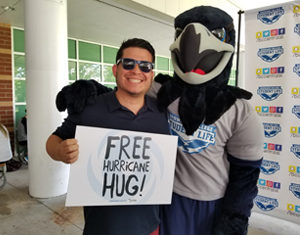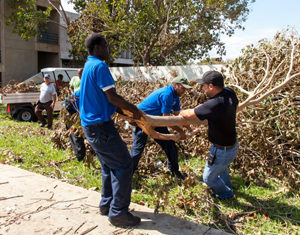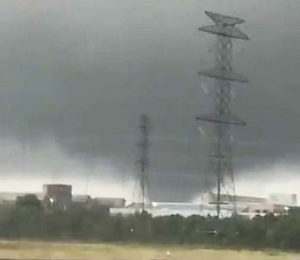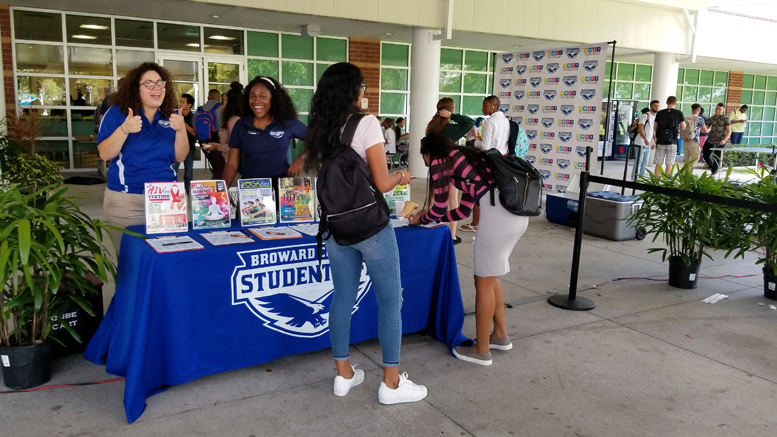Students returning to Florida’s Broward College this week were greeted with a party, as the college is reaching out to help students get back to normal after Hurricane Irma.
The celebration featured free donuts and pizza, music, games and hugs – in line with the college’s #HurricaneHugs Twitter campaign.
“We’re trying to make it positive,” said President J. David Armstrong, Jr. Broward is projecting a 4 percent or 5 percent enrollment decrease, as students find education becomes a lesser priority in the face of significant property losses and family issues.
Elsewhere in Florida, colleges affected by Irma either are not expecting big enrollment losses or haven’t yet determined how many students will skip the semester.
In Texas, it’s a mixed picture, as some colleges are seeing enrollment losses and others are seeing gains, although not as large as expected before Hurricane Harvey.
For the many community colleges in both states struggling to recover, infrastructure repairs will mostly be covered by insurance, but solutions for enrollment losses are not as clear cut.
Twenty-four of the 28 community colleges in Florida – all but the ones in the panhandle – experienced some impact from Irma, according to Michael Brawer, executive director of the Association of Florida Colleges (AFC). South Florida State College, for example, experienced major damages. Although classes resumed September 20, many students and faculty were still without power, so it’s still too early to assess the full effect, said President Tom Leitzel.
AFC and its foundation have created the AFC Family Hurricane Relief Fund, to which they have contributed $20,000. The fund will provide financial support up to $500 to AFC members who experienced extensive loss to personal property and possessions during Hurricane Irma.
Getting up to speed
As a result of the storm, Broward will take a financial hit of as much as $8 million, Armstrong said. That’s for repairs to facilities and grounds, overtime for grounds crews and other staff, vendors for mitigation, and lost tuition revenue.

Sammy Seahawk greets students with hugs as they return to Broward College after Hurricane Irma. (Photo: Broward College)
The college opened its advising center before classes resumed and contacted students via hotlines, robo-calls and social media to urge them to come back to school.
“We’re answering their questions and telling them if they come back to class we’ll get you back on track, faculty will address your issues and we’ll help with transportation and mental health concerns,” he said.
Despite those efforts, “there’s only so much you can do,” Armstrong said. “People’s lives are impacted.”
Physically, the college is “in pretty good shape, due to the incredible work from our teams,” he said. “Other than power outages and roof damage, we dodged a major catastrophe.”
The rest of the community wasn’t so lucky. About 200,000 people were still without power days after the storm while temperatures soared. Broward opened its cafeteria to the community, invited people without water at home to use its gym showers and provided free wi-fi and drinking water.
Meanwhile, administrators, deans and faculty are working on a plan to make up for the lost time. It’s especially problematic for courses held only on Fridays and weekends, which lost two weeks of sessions, Armstrong said. Some courses also have to build in extra time to prepare for national certification exams, which can’t be postponed.
Faculty met within their pathways communities to brainstorm academic and curriculum issues. Because many adjuncts scattered after the storm, a full-time faculty member is being assigned to each class taught by an adjunct to help adjust the calendar and make up missed classes.
Cleaning up
At Miami Dade College there were power outages, lots of downed trees and “minor water intrusion in some classrooms where rain was blown in,” but no major structural damages, said Juan Mendietta, the college’s communications director.
The most serious problem had to do with the possibility that a building on the Wolfson campus downtown might have to be closed following the collapse of a construction crane next to it during Irma’s high winds.
Florida State College at Jacksonville (FSCJ) also experienced some water damage and power outages, reported spokesperson Jill Johnson. While the campus was closed, several buildings near the shore were used as holding facilities for first responders.
Even though many students had more extensive damage and extended power outages, most of them returned when the college reopened on September 18.
To make up for the missed days, FSCJ will move some classes around and find other creative ways to ensure students will receive all the instruction necessary to complete the academic term, Johnson said.
Impact on enrollment
In Texas, many community colleges had projected large enrollment increases, mainly due to a new state law easing rules on dual-enrollment programs, said Dustin Meador, director of government relations at the Texas Association of Community Colleges (TACC). Colleges affected by Hurricane Harvey, however, are seeing those gains diminish.

Workers clear downed trees at Miami Dade College. (Photo: MDC)
The College of the Mainland, for example, projected a 17 percent increase in enrollment. After Harvey, enrollment was up 9 percent, but during a conference call with TACC on September 12, “the lobby was full of students dropping out,” Meador said.
Galveston College lost a third of its students in 2008 when Hurricane Ike struck the area, but those kind of losses aren’t happening this time, he said. In fact, enrollment is projected to increase 9 percent, although students still have the option to withdraw and get a full refund.
Enrollment is up 4 percent at San Jacinto College, he said, and Lee College reported a 9 percent increase but lost 400 students the day of the conference call. Blinn College saw its enrollment shrink 2 percent. Victoria College had been expecting a 2 percent to 3 percent increase but now enrollment is flat.
Meador said hurricane damage estimates at Texas colleges are $1 million at San Jacinto, $500,000 to $600,000 at Galveston, $500,000 at Alvin Community College, $500,000 at Wharton County Junior College, $350,000 at Victoria College, and $40,000 at Lee College.
Flooding was so severe in Wharton County that many professors’ houses were completely under water, and the mosquito population got so thick, some livestock actually suffocated, Meador noted.
Emergency aid
The Harvey HELP fund set up to aid Texas colleges affected by Harvey has so far raised about $44,000, Meador said. The funds will be distributed to colleges to backfill their emergency grant aid programs for students.
Steve Head, chancellor of the Lone Star College (LSC) system in Houston, estimates the college’s foundation will spend at least $700,000 and possibly as much as $1 million on emergency relief.
Any student or employee can apply for up to $1,000 in aid if they had property or car damage or moving expenses due to Harvey. An anonymous donor who earlier contributed $500,000 to the foundation for hurricane aid has pledged another $500,000.
The LSC system is in better shape following Hurricane Harvey than college leaders initially thought. Although repair costs have grown since initial estimates, the impact on enrollment won’t be as bad as expected, said Head, who is a member of the American Association of Community Colleges board of directors.
Lone Star, which serves 89,400 students, sustained about $30 million in infrastructure damages. Much of that is from flooding, although as the hurricane approached, a tornado clipped the roof of a building at its CyFair campus before wiping out two nearby houses.
About $10.5 million to $11 million should be covered by insurance, Head said. Lone Star will also receive some funding from FEMA, and plans to reallocate some unused bond money and tap cash reserves.
“We’re in good shape financially,” Head said.

A tornado at Lone Star College’s CyFair campus. (Photo: Tess Eugenio)
The majority of the damage, about $25 million, was at the Kingwood campus, where six of the nine buildings had up to four feet of water from a river that overflowed due to heavy rains plus the overflow from a backed up sewer system. Kingwood will probably remain closed until early summer 2018, Head said, as it will take months to clean and remodel flooded buildings and replace the data center, chillers, generators and transformers. Kingwood classes, however, will resume September 25 in temporary locations, including a church and community center.
Enrollment at Kingwood, which serves about 13,000 students, is actually up 5 percent from earlier projections, Head said, while the headcount at Lone Star overall is up 4 percent from last year.
“We really worked hard to reach out to students with emails and cards telling them to stick with us,” Head said. “We sent a message urging them not to drop out and that we would have classes no matter what.”
Before Harvey, Lone Star was actually projecting an 8 percent to 9 percent increase, and once the hurricane was forecast, it was determined that “as long as we’re at 3 percent, we would be fine,” Head said.
The college made every effort to retain students: Late fees and any debt less than $50 were waived; students were allowed to register a week after classes started; and anyone could get a full refund.
Head attributed the projected enrollment gains at LSC to affordability (tuition is just $70 per credit hour), along with convenience, robust student services, a wide selection of courses (more than 12,000 per semester) and a big growth in online courses.
Most of all, Head said, “It’s the quality of our programs. Our students do very well whether they transfer or go into the workforce.”

